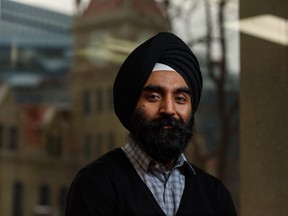
Article content
Recently, the ghosts of Green Line past once again rose from the ashes to make their same tired arguments against the project. These “concerned citizens” keep looking for new opportunities to try to scare Calgarians and corporations away from building what will be one of the most transformational projects in our city’s history.
Led by a small group of men once considered to be visionary city builders, an ambitious transit project has mysteriously drained them of their civic mojo. Their tactics keep changing but their arguments do not.
Advertisement 2
Article content
Article content
They like to say building the Green Line will cost too much money, the line doesn’t reach far enough into southeast Calgary, governance is not open or transparent, and nobody uses transit after COVID. Let’s take a moment to explore why they’re on the wrong track.
Rome wasn’t built in a day and neither was Calgary’s current LRT network. To suggest that Stage 1 of Green Line must be all things to all people right from the get go to be considered worthwhile is to ignore Calgary’s own history of building light rail.
When the Red Line LRT first opened in 1981, the track stretched from downtown Calgary to Anderson station. Stage 1 of Green Line, connecting Eau Claire with Shepard, will accomplish something similar with two key differences. The first is that Shepard station will be about 10 blocks farther south than Anderson. The second is that unlike Anderson station in the ’80s, more than 100,000 Calgarians already live a short drive or bus ride from Shepard station, with more people arriving daily.
In the decades since the LRT first opened, Calgary has wisely continued to invest in expanding the network, and the same will be true for the Green Line. The dividends it’s provided in fighting traffic congestion and allowing all citizens to move about our city are invaluable. Yes, transit investment costs money, but Calgarians have never had to go it alone.
Article content
Advertisement 3
Article content
Beginning in 2026, the Government of Canada will launch a new transit fund with $3 billion per year up for grabs. In this year’s austerity budget, the provincial government still managed to find $43 million to put toward extending Calgary’s Blue Line LRT. Green Line will one day stretch 46 kilometres, from Keystone in the north to Seton in the south. With federal and provincial partners willing to share the financial heavy lifting, Calgary can afford to keep building the Green Line.
One thing Calgarians can’t afford is further delays on this important project. Since city council first approved the Green Line plans in 2017, Calgarians have been stuck on a merry-go-round of planning and budget debates. Every day of delay adds to the project cost. The cheapest time to start building was yesterday. The next cheapest time is today.
Procurement for Green Line construction is underway and any company bidding on it will always price in risk. They do not want to invest in hiring and equipment if they feel there is a risk the project might not be built.
At a recent board meeting, Green Line CEO Darshpreet Bhatti commented that local subcontractors are coming in with quotes much higher than anticipated due to the perceived risk. Opponents know this and are hoping to break the Green Line budget by pumping up the uncertainty to further inflate bids. Taxpayers should not let them get away with picking our pockets. We need our elected representatives to send a firm message that they’re committed to this project being built.
Advertisement 4
Article content
The existence of the Green Line board should also provide Calgarians with some reassurance that their money is being managed properly. Opponents have long asked for a way to review costs and decision-making that’s arm’s-length to city hall. With an independent Green Line board stacked with experts on megaprojects and governance, Calgarians have gotten exactly that.
Back in the ’80s, a group of concerned citizens made headlines opposing the construction of Calgary’s LRT based on cost and ridership projections. Ralph Klein was mayor at the time. He knew to keep pushing forward on construction and that a vocal minority should not be allowed to stand in the way of progress.
Today, Calgary has the busiest LRT network in North America. Our latest group of concerned citizens remain in the minority as a recent city hall survey reported 92 per cent of Calgarians support the Green Line. Klein made the right call back then, and building Green Line is the right call now.
Calgary city council needs to channel the spirit of Klein, stick to its guns, stop debating, avoid dithering and start building.
Jeff Binks is the president of LRT on the Green, a volunteer-driven community not-for-profit governed by a board of seven from Green Line communities that is celebrating its 10th anniversary advocating for improved transit in Calgary.
Article content



